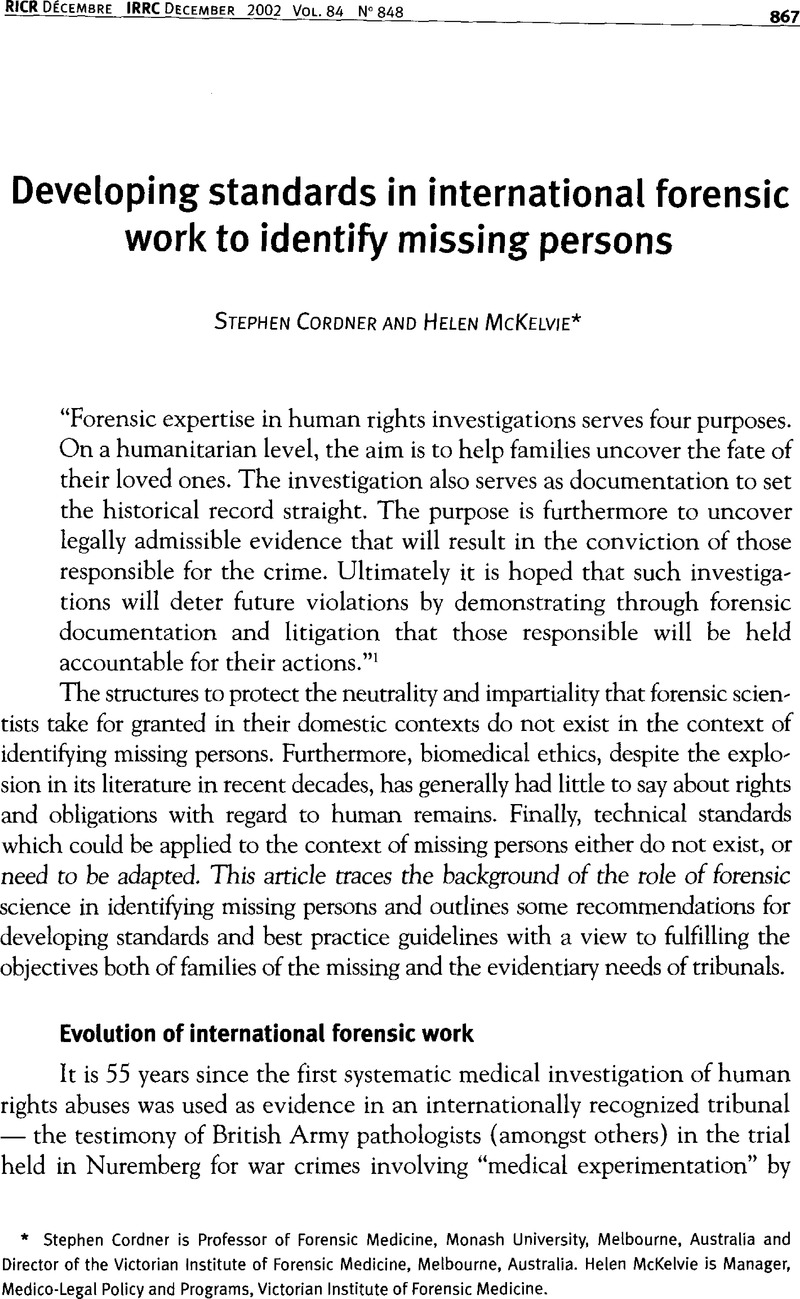Published online by Cambridge University Press: 19 April 2010

1 Kirschner, R. and Hannibal, K., “The application of forensic sciences to human rights investigations”: Medicine Science and Law, Vol. 13, 1994, p. 453.Google Scholar
2 Kirschner, and Hannibal, , op. cit. (note 1), p. 451.Google Scholar
3 Hannibal, K. and Lawrence, R., “The health professional as human rights promoter: Ten years of physicians for human rights (USA)”, Health and Human Rights, Vol. 2, No. 1, p. 112.Google Scholar
4 Ibid., p. 113.
5 Over the last 16 years PHR, based in Boston, has sent more than 75 medical and forensic teams to dozens of countries to carry out forensic investigations, including exhumations and autopsies of deceased victims of alleged torture and extrajudicial executions in Brazil, Israel, Czechoslovakia, Guatemala, Honduras, El Salvador, Iraqi Kurdistan, Kuwait, Mexico, Panama, Rwanda, Thailand, the former Yugoslavia and very recently, Afghanistan. <http://phrusa.org/research/forensic/croatia/forvuk3.html>.
6 <http://www.phrusa.org/research/forensics/index/html>.
7 Blewitt, G., “The role of forensic investigations in genocide prosecutions before an international tribunal”, Medical Science Law, Vol. 37, No. 4, 1997, pp. 286–7.Google Scholar
8 <http://www.phrusa.org/research/forensics/index/html>.
9 <http://hrdata.aaas.org/ceh/report/english/recS3.html>.
10 E/CN.4/RES/1993/33 Preamble and para. 3.
11 E/CN.4/RES/1993/31, para. 3.
12 See E/CN.4/1993/2O, 5 February 1993, para. 3 and E/CN.4/1993/20 para. 18.
13 E/CN.4/1998/32, 5 January 1998, 1, D, 3.
14 Blewitt, , op. cit. (note 7), p. 284.Google Scholar
15 Ibid., p. 288.
16 Rainio, J., Lalu, K. and Penttila, A., “Independent forensic autopsies in an armed conflict: Investigation of the victims from Racak, Kosovo”, Forensic Science International, Vol. 116, 2001, p. 166.Google Scholar
17 Sprogoe-Jakobsen, S. et al. “Mobile autopsy teams in the investigation of war crimes in Kosovo 1999”, Journal of Forensic Science, Vol. 46, No. 6, 2001, p. 1392.Google Scholar
18 Rome Statute of the International Criminal Court of 17 July 1998, Art. 5.
19 Blewitt, , op. cit. (note 7), p. 288.Google Scholar
20 Ibid., pp. 277–8.
21 Ibid., p. 288. Emphasis added.
22 A Danish-Swedish team of forensic scientists working for the ICTY have also made this observation. Sprogoe-Jakobsen, et al. op. cit. (note 17), p. 1395.Google Scholar
23 Cordner, S., El Nageh, M., Wells, D., McKelvie, H. and Lineham, B., Ethical Practice in Laboratory Medicine and Forensic PathologyGoogle Scholar, WHO Regional Publication, Eastern Mediterranean Series 20, EMRO, 1999, p. 37.
24 Sprogoe-Jakobsen, et al. op. cit. (note 17), pp. 1392–3.Google Scholar
25 Rainio, et al. op. cit. (note 16), p. 173.Google Scholar
26 Ibid., p. 177.
27 Ibid., p. 171.
28 Ibid.
29 G. Hutchins, Autopsy Committee of the College of American Pathologists, “Practice guidelines for autopsy pathology: Autopsy performance”, Archives of Pathology and Laboratory Medicine, Vol. 118, 1994, pp. 19–25Google Scholar, and “Practice guidelines for autopsy pathology: Autopsy reporting”, Archives of Pathology and Laboratory Medicine, Vol. 119, 1995, pp. 123–130Google Scholar; The Royal College of Pathologists, Guidelines on Autopsy Practice, <http://www.rcpath.org>; K. Bove, Autopsy Committee of the College of American Pathologists, “Practice guidelines for autopsy performance: The pre-natal and paediatric autopsy”, Archives of Pathology and Laboratory Medicine, Vol. 121, 1997, pp. 368–376Google Scholar; J. Powers, Autopsy Committee of the College of American Pathologists, “Practice guidelines for autopsy pathology: Autopsy procedures for brain, spinal cord and neuromuscular systems”, Archives of Pathology and Laboratory Medicine, Vol. 119, 1995, pp. 777–783.Google Scholar
30 Available from the Interpol website <http://www.interpol.int>.
31 These include World Medical Association; Indo Pacific Association of Law Medicine and Science (INPALMS); World Association of Societies of Pathology; Physicians for Human Rights; European Network of Forensic Science Institutes; American Society of Crime Laboratory Directors (this organization accredits many laboratories outside the US); European Academy of Forensic Sciences; and International Academy of Legal Medicine.